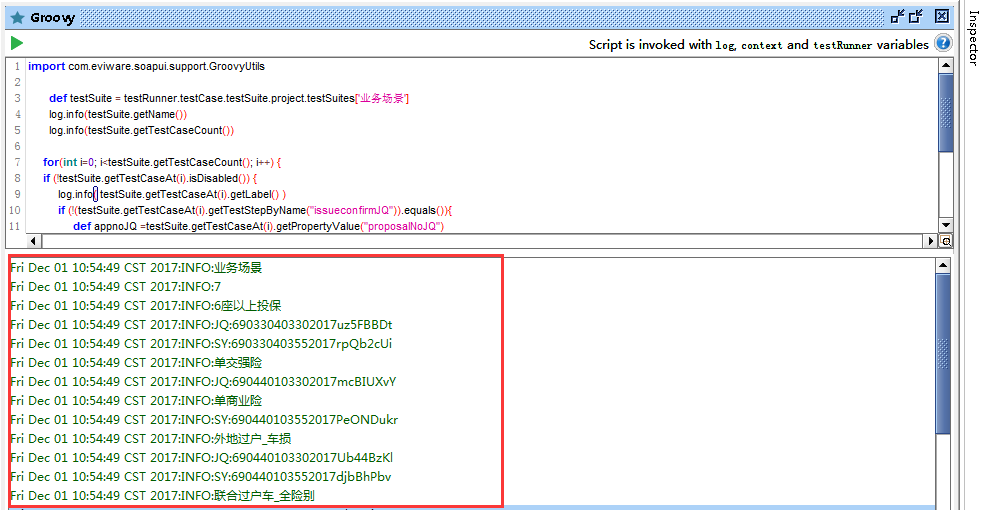------Groovy脚本常用方法
1. 设置参数值:setPropertyValue
a. 设置 project level property
//set to project level property 下面两种写法都可
testRunner.testCase.testSuite.project.setPropertyValue("Name", "propValue");
testRunner.testCase.getTestSuite().getProject().setPropertyValue("Name", "propValue");; //项目对象
b. 设置 testSuite level property
//set to testSuite level property
testRunner.testCase.testSuite.setPropertyValue("Name","testSuiteValue");
testRunner.testCase.getTestSuite().setPropertyValue("Name","testSuiteValue");
c. 设置 testCase level property
//set to testCase level property
testRunner.testCase.setPropertyValue("Name","testCaseValue");
d. 设置 testStep level property
//set to testStep level property
testRunner.testCase.testSteps['Groovy'].setPropertyValue("Name","testSuiteValue");
testRunner.testCase.getTestStepByName("Groovy").setPropertyValue("Name","testSuiteValue");
2. 定位到某个testSuites
def testSuite = testRunner.testCase.testSuite.project.testSuites['testSuites Name'];
3. 获取TestCase个数:getTestCaseCount()
for(int i=0; i<testSuite.getTestCaseCount(); i++) {
if (!testSuite.getTestCaseAt(i).isDisabled()) {
if (!(testSuite.getTestCaseAt(i).getTestStepByName("stepName")).equals()){
.....
}
}
}
4. 获取TestSuite个数:getTestSuiteCount()
testRunner.testCase.testSuite.project.getTestSuiteCount()
5. 获取名称
a. 取test case的名称:getLabel()
def tc = testRunner.testCase;
log.info (tc.getLabel());
b. 取test suite的名称:getLabel()
def ts = testRunner.testCase.testSuite;
log.info (ts.getLabel());
c. 取project 名称
def tp = testRunner.testCase.testSuite.project;
log.info (tp.getName());
6.层级访问
testRunner.testCase.testSuite.project.testSuites[testSuiteName].testCases[testCaseName].testSteps[testStepName]
/*Case1:练手详图如下*/
import com.eviware.soapui.support.GroovyUtils
def testSuite = testRunner.testCase.testSuite.project.testSuites['业务场景']
log.info(testSuite.getName())
log.info(testSuite.getTestCaseCount())
for(int i=0; i<testSuite.getTestCaseCount(); i++) {
if (!testSuite.getTestCaseAt(i).isDisabled()) {
log.info( testSuite.getTestCaseAt(i).getLabel() )
if (!(testSuite.getTestCaseAt(i).getTestStepByName("issueconfirmJQ")).equals()){
def appnoJQ =testSuite.getTestCaseAt(i).getPropertyValue("proposalNoJQ")
log.info( "JQ:"+ appnoJQ)
}
if (!(testSuite.getTestCaseAt(i).getTestStepByName("issueconfirmSY")).equals()){
def appnoSY =testSuite.getTestCaseAt(i).getPropertyValue("proposalNoSY")
log.info( "SY:"+ appnoSY)
}
}
}
层级关系如下图所示

log 如下图:

7.SoapUI允许在项目的各个层次中定义变量,常用的层次包括: Project,TestSuite,TestCase,Global等
如果在 Groovy Script中使用这些全局变量的话,可以用以下方法:
def time_num= context.expand ('${#Project#hospitalId}') //##号内为定义哪个级别的属性变量,后面为属性名